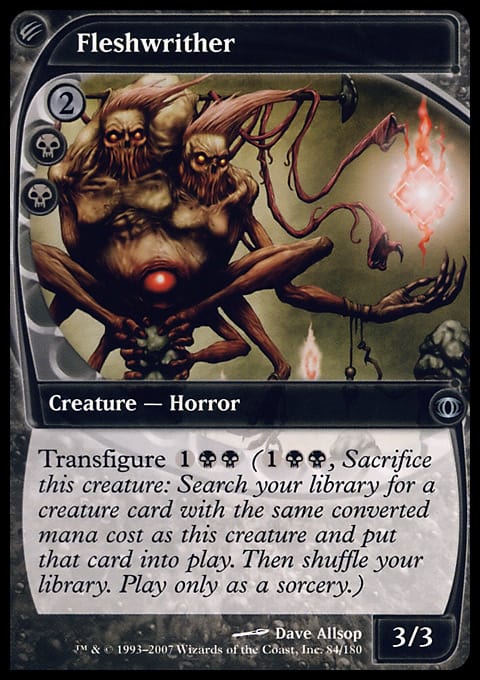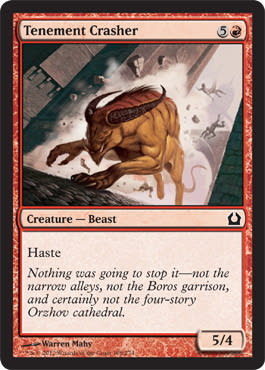I jumped the gun a little bit with Rakdos Week in my previous article, but that article split things up between all four red-based Ravnica guilds and focused on the Dragon side of things. This week, we’ll focus all on the Demon side. Speaking of Demons, isn’t this B/R guild named after one?
Now, some of you may be aware of a mechanic called paincast. Probably for the best, the mechanic was replaced in the design file by a mechanic called unleash. Mark Rosewater discusses the failings of paincast in this article; however, Wizards of the Coast did decide to leave the mechanic, sans keyword, on a single card in the set, though it virtually grants the ability to other creatures rather than have it for itself.
Let’s break it. Today, I’m going to be building around Rakdos, Lord of Riots. This millennia-old Demon has been the leader of the Cult of Rakdos since it was founded (coincidence?), and he’s going to headline this deck as well. Let’s get started and list the deck’s pieces by their roles.
Casting Rakdos
To make the deck work, we’re going to need to be able to cast Rakdos and use his superpower. Check out this little line of text:
That means we’re going to need cards that make opponents lose life. To cast Rakdos as soon as possible (how about turn four?), let’s see if we can find ways to make the opponents lose life while we spend little to no mana on the turn we want to cast our Demon.
Rift Bolt – Suspend is a demonsend here. With three lands on the battlefield and a fourth in hand, we can suspend Rift Bolt, cast it during our next upkeep, play our fourth land, and cast Rakdos, Lord of Riots without worrying about pesky things such as attacking. As with all the cards in this section, it is also very helpful once Rakdos is already in play to reduce the cost of follow-up creatures without making us spend any mana.
Emberwilde Augur – The time-based mechanics are great for letting us deal damage without spending mana, and fortunately, the time-based block followed up Time Spiral’s Rift Bolt with Future Sight’s Emberwilde Augur. This guy can even attack, potentially dealing more than just his prescribed 3 damage. The downside of these two cards, though, is that if you don’t have the fourth land or the Rakdos, you have to make the decision of whether to blow the card before seeing your next draw step.
Necrogen Censer – Though it may have seen some play in casual proliferate decks or something, this card has always been very low-profile, even in its own Limited environment. However, it does some unique work here. Playing a Censer on turn three lets us cast Rakdos on turn four while leaving another counter to reduce the cost of our creatures on later turns.
Scroll of Griselbrand – This is another card that just doesn’t have a lot of homes. It’s like a Ravenous Rats that can’t enjoy creature-recursion synergies and that can never block, though it sometimes gets in for 3. Fortunately for this deck, when it does get in for 3, it’s all at once and we have a Rakdos, Lord of Riots on the battlefield, so we get to paincast. Even still, perhaps these slots should be Bump in the Nights, but I just can’t resist giving the poor card a home.
Pain's Reward – This is an interesting card I found while researching options for the deck, and as is the case with many Kamigawa-block cards, I had no recollection of ever seeing it before. Often with this deck, we’ll be able to afford bidding more life than our opponent, so we’ll get to draw four cards. The downside is that our opponent won’t have lost any life for us to paincast. And in the event our opponent is the one paying life, we didn’t get to draw the cards to maximize the large paincast. However, drawing four cards can’t be bad, and again, I want to give the poor card a home.
Piranha Marsh – Another tapped land isn’t great, and 1 life isn’t a lot, but in a pinch (ha!), the Marsh can let us cast Rakdos or potentially save us 2 or more mana with paincast online.
Finding Rakdos
Unfortunately for us combo players, there is a pesky rule about only playing four of a given card in a given deck. That means in order to really get our pain-fueled engine online, we’ll need to find other ways to provide ourselves with redundancy for the guild-eponymous Demon.
Rakdos, Lord of Riots – Let’s play four copies!
Blood Speaker – The downside of this guy is that he costs 4 mana, taking up the turn we want to be putting the parun in play already. However, his effect is quite powerful. In fact, this deck can take even more advantage of him than other decks I’ve seen. Sacrifice this Ogre Shaman to find Rakdos, and when the paincast pleasure begins, recast him for only ![]() . If only we’re able to find more useful Demons for the deck, he can keep the demonic stream flowing for very little mana.
. If only we’re able to find more useful Demons for the deck, he can keep the demonic stream flowing for very little mana.
Fleshwrither – There is one card in all of Magic: The Gathering with the transfigure keyword, and this is it. It’s like transmute-onto-the-battlefield. Conveniently, the one transmute card happens to have the same mana cost as our behated Demon. This little trick also avoids Rakdos’s own pain requirement. Since you put him directly onto the battlefield instead of having to cast him, you won’t have to worry about dealing any damage the turn you put Rakdos into play. Another option for this card slot would be Dimir House Guard. The reversal of the mana-requirement order (3 to transmute and then 4 to cast Rakdos instead of 4 to cast Fleshwrither and 3 to transfigure it) means Rakdos can come out on-curve, but only if you cast Emberwilde Augur on the second turn. That limitation combined with the Skeleton’s blatant reference to another guild means he loses his spot to the more unique Future Sight Horror.
Obviously, cards such as Vampiric Tutor and Demonic Tutor would fit in great, but those are a little more pricey and unfair than I prefer. When I crush my opponents, I want it to be on the back of strange synergies and not the raw power of individual cards. The more accessible Diabolic Tutor could do the job, but not as well as the above Ogre or Horror. All that said, as with any black deck, if you have Demonic Tutors and want to play them, go ahead.
Paincasting!
Well, we finally found Rakdos and were able to put him onto the battlefield. We may be paincasting post-combat, having attacked for 6 with our flying Demon, or we may have dealt some Emberwilde or Rift damage and be going for it pre-combat, but let’s take a look at the big beaters we want to plop on the table.
Tenement Crasher – This newcomer is actually the best in a progressing series of 5/4 haste creatures for ![]()
![]() . Fifth Dawn had Iron-Barb Hellion, which couldn’t block, Scars of Mirrodin had Flameborn Hellion, which attacked each turn if able, and Return to Ravnica’s Tenement Crasher just has haste and none of the downside. While I’d normally prefer to make some kind of split between otherwise-identical cards, I just can’t overlook the downsides.
. Fifth Dawn had Iron-Barb Hellion, which couldn’t block, Scars of Mirrodin had Flameborn Hellion, which attacked each turn if able, and Return to Ravnica’s Tenement Crasher just has haste and none of the downside. While I’d normally prefer to make some kind of split between otherwise-identical cards, I just can’t overlook the downsides.
Minotaur Aggressor – I ended up making the split between the above Beast and this new Minotaur from the same set. The extra mana can be an issue, though, even in a deck like this one. Imagine you’ve just dealt 3 damage with a Rift Bolt, and you have six lands and a Rakdos. With two Tenement Crashers, you could cast both of them pre-combat and attack for 10. When either or both of those is Minotaur Aggressor, you’ll only be able to cast one. That said, I decided to skew in favor of the higher power and first strike, but it’s possible these should both be Beasts.
Artisan of Kozilek – This guy’s on the pricey end, but all of his mana is colorless, so he can potentially be free. Of course, if he’s free, that means we’ve dealt 9 damage that turn, and so someone’s pretty close to dead, and the Eldrazi might just be overkill. But the deck is all about overkill, as that’s really the only place to go once you’ve already resolved a 6/6 flying and trampling Demon for 4. Grab something huge that died to removal or just rebuy an Augur for 3 more damage.
Rune-Scarred Demon – Weren’t we looking for another Demon for our Blood Speakers? With two of these, one can grab the other, and potentially, for only
Avatar of Slaughter – This card is the epitome of the deck’s overkill options. A reasonable sequence is dealing 2 damage on turn four with a Necrogen Censer in order to cast Rakdos, dealing 8 damage on turn five with the Censer and the Demon, and then 40 or more damage on turn six with the Avatar and a horde of paincasted monstrosities. Perhaps multiplayer play is a good option for this deck, as you can put that extra damage to good use.
Kozilek, Butcher of Truth – One risk of almost any B/R deck is running out of cards. Unlike our Dissension friends, we’re not playing with hellbent here, but we are in the market for making expensive things free, and this guy can help us with all that.
Phyrexian Colossus – If we want to block, maybe this should be Myr Battlesphere, but that card already sees enough play . . . and we don’t want to block anyway. Instead, let’s make an 8/8 that can’t be blocked except by three or more creatures and then give it double strike with Avatar of Slaughter. When the deck floods the board with fatties, not all of them can be chump-blocked—especially when one of them is this guy. I look forward to the day I get to pay 8 life to untap him for value.
Paincast Combos
Wait. Wasn’t that the combo already? Play Rakdos, Lord of Riots, deal damage, and cast huge guys for cheap? Nope! We can do better!
Goretusk Firebeast – Sometimes, we attack for 6 and it just isn’t enough. Maybe we want to cast Kozilek and the two copies of Artisan of Kozilek we drew off his trigger. In that case, spend 1 mana to cast this long-forgotten Judgment common, and chop 4 more mana off all those spells’ costs. And check out that flavor text.
Laquatus's Champion – Long one of my favorite cards, the Otaria Merfolk’s Nightmare Horror pit fighter fills the same role as the Firebeast, but for 2 more damage and for ![]()
![]() instead of
instead of ![]() . The mana can often be a difference, and the life can be gained back by your opponent, but you still get the paincast value, and regenerating for
. The mana can often be a difference, and the life can be gained back by your opponent, but you still get the paincast value, and regenerating for ![]() is nice.
is nice.
Composite Golem – And here’s the kicker. (No, your Rumbling Aftershocks doesn’t trigger.) One hit with Rakdos or a Rift Bolt paired with a Scroll of Griselbrand means Composite Golem is free. And if you need that little mana push to cast an Eldrazi, he’s your man. He can even help you hit that colored mana you need. Imagine tapping out to maximize paincast. You’ll be stuck with your colored creatures in your hand, but a Composite Golem will give you ![]()
![]() to play with. That’s enough for a Minotaur Aggressor and a Blood Speaker. And if you tapped all your lands except two Rakdos Guildgates, you’d have to choose between Avatar of Slaughter and Rune-Scarred Demon. But with a Composite Golem to give you
to play with. That’s enough for a Minotaur Aggressor and a Blood Speaker. And if you tapped all your lands except two Rakdos Guildgates, you’d have to choose between Avatar of Slaughter and Rune-Scarred Demon. But with a Composite Golem to give you ![]()
![]() , you can tap your Guildgates for the other
, you can tap your Guildgates for the other ![]()
![]() needed to cast both. The Golems beat out Priest of Urabrask and Priest of Gix because of its colorless mana requirement and higher yield, but it provides the additional upside of enabling splashes. I avoided Maelstrom Wanderer to keep from diverging from Rakdos Week’s theme, but that guy would make for even crazier turns than are already possible.
needed to cast both. The Golems beat out Priest of Urabrask and Priest of Gix because of its colorless mana requirement and higher yield, but it provides the additional upside of enabling splashes. I avoided Maelstrom Wanderer to keep from diverging from Rakdos Week’s theme, but that guy would make for even crazier turns than are already possible.
"Paincast Party"
- Creatures (28)
- 1 Avatar of Slaughter
- 1 Goretusk Firebeast
- 1 Laquatus's Champion
- 1 Tenement Crasher
- 2 Artisan of Kozilek
- 2 Blood Speaker
- 2 Fleshwrither
- 2 Minotaur Aggressor
- 2 Rune-Scarred Demon
- 4 Emberwilde Augur
- 1 Phyrexian Colossus
- 4 Composite Golem
- 1 Kozilek, Butcher of Truth
- 4 Rakdos, Lord of Riots
- Spells (9)
- 1 Pain's Reward
- 4 Rift Bolt
- 2 Necrogen Censer
- 2 Scroll of Griselbrand
- Lands (23)
- 5 Mountain
- 5 Swamp
- 1 Piranha Marsh
- 4 Blood Crypt
- 4 Dragonskull Summit
- 4 Rakdos Guildgate
That about wraps it up for Rakdos Week! Until next time, I’m Andrew saying, “Diplomacy has solved nothing. Only bloodspill can end this now. Call forth the warbringer.”
Andrew Wilson
fissionessence at hotmail dot com


























